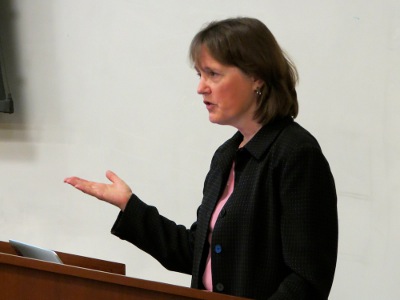Computer Science Mini-Summit reveals trouble with high school CS curricula
Filling the Black Hole
On August 8, 2012, Computer Education for the 21st Century’s Computer Science Education Mini-Summit revealed the problem with high school Computer Science curricula, and, more importantly, what’s being done to fix it.
Photos: Shelby Clarke
 “High School is a black hole for most students with respect to Computer Science,” says Jan Cuny, the National Science Foundation’s (NSF) Program Director for Computing Education. In August, Cuny spoke about the scarcity of Computer Science in High Schools and what’s being done to encourage students—especially women and minorities—to pursue the field.
“High School is a black hole for most students with respect to Computer Science,” says Jan Cuny, the National Science Foundation’s (NSF) Program Director for Computing Education. In August, Cuny spoke about the scarcity of Computer Science in High Schools and what’s being done to encourage students—especially women and minorities—to pursue the field.
This was music to the ears of the roughly fifty high school and middle school teachers, university professors, and administrators that attended Computer Education for the 21st Century (CE21)’s Computer Science Education Mini-Summit at UMBC. The brainchild of CSEE professors Marie desJardins, Penny Rheingans, and CWIT’s Associate Director, Susan Martin, the day-long summit was a way for Computer Science teachers to network, share best teaching practices, and get involved in fixing a problem close to their hearts.
Probably more telling than any facts or figures on the subject was the testimony of four high school and middle school Computer Science teachers, which told how widely the high school Computer Science experience varies across our state. Dianne O’Grady-Cunniff, who teaches classes like Web Design, Keyboarding, and Introduction to Engineering Design, says that the success of her Computer Science program at Westlake High School is largely due to her school administration’s outpouring of support.
But, support and resources must go hand in hand for success. Femi Ajimatanrareje of Prince Georges County’s DuVal High School knows this first-hand. While the administration supports his vision, resources have been hard to come by. In order to teach courses like Introduction to Engineering Design and Foundation to Technology, Ajimatanrareje had to pick up a class supply of computers and then network them himself.
Then there are schools that have the resources but lack support. Nancy Ale, who teaches courses like Software Applications, Information Communication Technology, Robotics, and Internet Safety to Sixth graders, is facing resistance from an administration that wants her to backpedal by teaching Keyboarding instead.
Most troubling are Computer Science programs that are desperate for both resources and support. Peter O’Conner, who teaches Intro to Computer Science and AP Computer Science at Boonsboro High School in Western Maryland, has to teach Computer Science in the school’s Chemistry lab. Not only are resources stretched, but O’Connor attributes a lack of understanding of the discipline on the part of guidance counselors, the administration, parents, and even students, to low enrollment. That coupled with the courses’ distinctions as electives, means that few students are willing to take his courses when familiar offerings like Art or Tech Ed would suffice. Out of the few students who do pursue Computer Science are even fewer women. In a course of 20 students, says O’Conner, he might only have two girls.
 One thing that the four teachers did have in common was the conviction that demystifying Computer Science to the masses is the first step in reversing the trend in waning enrollment levels. People hear Computer Science and think Microsoft Power Point or word processing. Or, if programming does come to mind, the concept is, at best, ambiguous, or, at worst, terrifying.
One thing that the four teachers did have in common was the conviction that demystifying Computer Science to the masses is the first step in reversing the trend in waning enrollment levels. People hear Computer Science and think Microsoft Power Point or word processing. Or, if programming does come to mind, the concept is, at best, ambiguous, or, at worst, terrifying.
Also crucial is the regulation of the subject at the state level. In her keynote speech, Jan Cuny shared staggering stats that reinforced the teachers’ testimony: Twenty years ago 25% of high schoolers took Computer Science, and now the figure is down to 19%. A mere 1% of students enter college claiming a Computer Science major. Out of that 1%, 0.3% are women.
So what’s the solution? A good first step is Computer Science: Principles, a future Advanced Placement (AP) Computer Science course being developed by the Collegeboard and NSF to help broaden participation in the field. As of now, there are more than 25 pilot sites in Berkeley, CA, Los Angeles, and Chicago that offer the class, but the goal is much broader. The CS 10K project strives to reach 10,000 teachers, and 10,000 schools by the fall of 2016. NSF has backed the program with $38 million in funds.
The proposed course will introduce high schoolers to programming and teach them the fundamental concepts of computing, how this knowledge can be applied, and how computing has the potential to change the world. As an AP course, it will act as a bridge to the study of Computer Science in college. The hope is that the course may help fill the widening Computer Science “black hole” and help foster future analytic minds capable of creating the technologies of tomorrow.
Posted: October 3, 2012, 8:28 AM